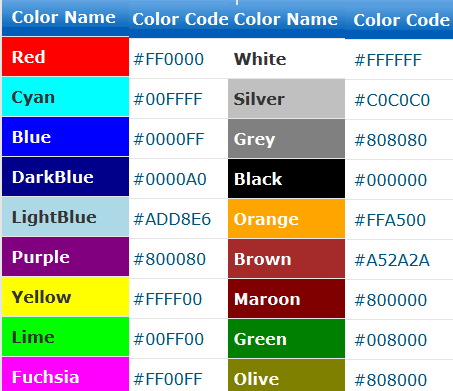HTML Colors

- HTML colors are used to specify the color of text, backgrounds, borders, and other elements on a webpage.
- HTML supports a variety of color formats, including named colors, hexadecimal colors, RGB values, and HSL values.
- Named colors are predefined colors that can be used by name, such as "red" or "blue".
- Hexadecimal colors are specified using a six-digit code that represents the amount of red, green, and blue in the color.
- RGB values are specified using a combination of red, green, and blue values, each ranging from 0 to 255.
- HSL values are specified using hue, saturation, and lightness values, each ranging from 0 to 100%.
- HTML colors can be specified using the style attribute on an HTML element, or in an external CSS stylesheet.
- HTML colors can be used to create visually appealing and engaging webpages, and can be used in combination with other HTML and CSS features to create complex designs.
- Web developers should use colors carefully and thoughtfully to ensure accessibility for users with visual impairments and color blindness.
Using Color Codes
- Black is represented by the hexadecimal color code #000000 or the RGB color code rgb(0,0,0).
- White is represented by the hexadecimal color code #FFFFFF or the RGB color code rgb(255,255,255).
- The color codes can be used to set the color of text, backgrounds, borders, and other elements on a webpage.
- The black and white color codes are often used as a default or fallback color for elements that do not have a specific color specified.
- The black and white color codes can be used in combination with other colors to create a visually appealing and engaging design.
- It is important to use sufficient contrast between black and white elements to ensure readability, especially for users with visual impairments.
- Web developers should also consider using shades of gray in addition to black and white to create a more nuanced design.
Here are some examples of color codes:
Using RGB Values
- RGB stands for "Red Green Blue" and is a color model used to create a wide range of colors in digital devices.
- RGB color codes are specified using three values that represent the amount of red, green, and blue in the color. Each value ranges from 0 to 255.
- The RGB color code format in HTML is "rgb(red, green, blue)", where red, green, and blue are integer values between 0 and 255.
- The RGB color model is additive, which means that colors are created by adding different amounts of red, green, and blue light.
- RGB color codes can be used to set the color of text, backgrounds, borders, and other elements on a webpage.
- RGB color codes can be used in combination with other colors and CSS features to create complex designs.
- It is important to choose appropriate RGB color values that are accessible for users with visual impairments and color blindness, and to test the colors to ensure they provide sufficient contrast.
Here are some examples of RGB values:
Using RGBA Values
- RGBA stands for "Red Green Blue Alpha" and is an extension of the RGB color model that includes an alpha channel, representing the color's transparency.
- RGBA color codes are specified using four values that represent the amount of red, green, blue, and alpha (transparency) in the color. Each value ranges from 0 to 255, except for alpha which ranges from 0 (fully transparent) to 1 (fully opaque).
- The RGBA color code format in HTML is "rgba(red, green, blue, alpha)", where red, green, blue, and alpha are integer or decimal values.
- RGBA color codes can be used to set the color and transparency of text, backgrounds, borders, and other elements on a webpage.
- They can be used in combination with other colors and CSS features to create complex designs with transparency effects.
- It's important to choose appropriate RGBA color values that provide sufficient contrast and transparency, and to test the colors to ensure they meet accessibility standards.
Here are some examples of RGBA values:
Using HSL Values
- HSL stands for "Hue Saturation Lightness" and is a color model used to define colors in terms of their hue, saturation, and lightness values.
- HSL color codes are specified using three values that represent the hue, saturation, and lightness of the color. Hue is measured in degrees on a color wheel, saturation is a percentage value that represents the intensity of the color, and lightness is also a percentage value that represents how light or dark the color appears.
- The HSL color code format in HTML is "hsl(hue, saturation%, lightness%)", where hue is the degree value between 0 and 360, and saturation and lightness are percentage values between 0% and 100%.
- HSL color codes can be used to create a wide range of colors with varying degrees of saturation and lightness, and can be used to create gradient effects.
- They can be used in combination with other colors and CSS features to create complex designs and effects.
- It's important to choose appropriate HSL color values that provide sufficient contrast and meet accessibility standards.
Here are some examples of HSL values:
